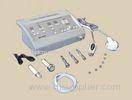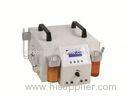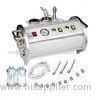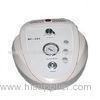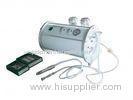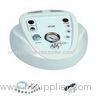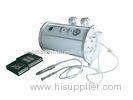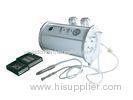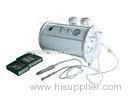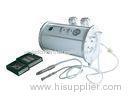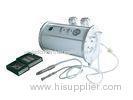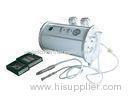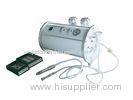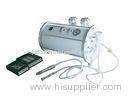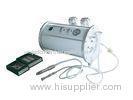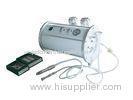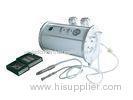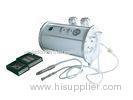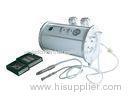|
WHYME Medical Beauty Commerce Co., Ltd
|
Mini 3 in 1 3 M Ultrasonic Skin Microdermabrasion Equipments home use Machine
| Place of Origin: | Zhejiang, China (Mainland) |
|
|
|
| Add to My Favorites | |
| HiSupplier Escrow |
Product Detail
Mini 3 in 1 3 M Ultrasonic Skin Microdermabrasion Equipments home use Machine
Mini 3 in 1 3 M Ultrasonic Skin Microdermabrasion Equipments home use Machine
1. Functions:
1. Electroporation
2. 3 M Ultrasonic
3. Diamond Dermabrasion
2. Electroporation Working Theory
Electroporation is a mechanical method used to introduce polar molecules into a host cell through the cell membrane. In this procedure, a large electric pulse temporarily disturbs the phospholipid bilayer, allowing molecules like DNA to pass into the cell.
3 in1 Electroporation
3. Technical parameters.
Power Input: 110V/60Hz or 220V/50Hz
Max. Power: 30 W
Temperature range: 10-42
4. Accessories
Main unit 1 pc
Electroporation Treatment probe 2 pcs
3M Ultrasonic Treatment Probe 2 pcs
Anode plate 1 pc
Treatment cable 1 pc
Power Cord 1 Pc
Manual 1 pc
Fuse 2 pc
Paper Carton 1 pc
Packing Foam 1 set
5. Background
Many research techniques in molecular biology require a foreign gene or protein material to be inserted into a host cell. Since the phospholipid bilayer of the plasma membrane has a hydrophobic exterior and a hydrophobic interior (Fig. 1), any polar molecules, including DNA and protein, are unable to freely pass through the membrane.
Figure 1. Diagram of the Phospholipid Bilayer. This image shows the chemical components of the plasma membrane. The polar head groups face outward while the hydrophobic tail groups face inward and interact with one another to hold the membrane together. Polar molecules cannot pass through this membrane without external aid.
Many methods have been developed to surpass this barrier and allow the insertion of DNA and other molecules into the cells to be studied. One such method is electroporation.
The concept of electroporation capitalizes on the relatively weak nature of the phospholipid bilayer's hydrophobic/hydrophilic interactions and its ability to spontaneously reassemble after disturbance. Thus, a quick voltage shock may disrupt areas of the membrane temporarily, allowing polar molecules to pass, but then the membrane may reseal quickly and leave the cell intact.
Procedure
The host cells and the molecules to be inserted into these cells are suspended in solution. The electroporation apparatus is typically commercially produced and purchased, but the basic process inside such an apparatus may be represented in a schematic diagram
Figure 2. Diagram of the basic circuit setup of the electroporation apparatus. This diagram shows the basic electric circuit that provides the voltage for electroporation.
When the first switch is closed, the capacitor charges up and stores a high voltage. When the second switch is closed, this voltage discharges through the liquid of the cell suspension. Typically, 10, 000-100, 000 V/cm (varying with cell size) in a pulse lasting a few microseconds to a millisecond is necessary for electroporation. This electric pulse disturbs the phospholipid bilayer of the membrane and causes the formation of temporary aqueous pores. The electric potential across the membrane of the cell simultaneously rises by about 0.5-1.0 V so that charged molecules (such as DNA) are driven across the membrane through the pores in a manner similar to electrophoresis (Fig 3)
Figure 3. Graphic representation of plasmids containing a foreign DNA insert passing through temporary aqueous pores in the plasma membrane. The actual entry of DNA into the cell cannot be observed with a microscope, but this artist's rendering shows the basic concept of the formation of pores in the membrane through which DNA can pass.
As charged ions and molecules flow through the pores, the cell membrane discharges and the pores quickly close, and the phospholipid bilayer reassembles. The intended molecules should now be inside the cell for further use or study.
6. Advantages and Disadvantages of Electroporation
Several methods other than electroporation are used to transfer polar molecules like DNA into host cells. These other methods include microprecipitates, microinjection, liposomes, and biological vectors. (Melcher, 2000). Electroporation has both advantages and disadvantages compared to these methods.
7. Advantages:
Versatility: Electroporation is effective with nearly all cell and species types.
Efficiency: A large majority of cells take in the target DNA or molecule. In a study on electrotransformation of E. coli, for example, 80% of the cells received the foreign DNA.
Small Scale: The amount of DNA required is smaller than for other methods.
In vivo: The procedure may be performed with intact tissue. A paper published in Developmental Biology showed the successful transfer of a DNA construct with a fluorescent reporter gene into intact mouse brain tissue (Fig 4).
Figure 4. Image of in vivo electroporation in a mouse brain. The mouse brains (telencephalons) in these images are expressing reporter genes (EYFP) introduced in gene constructs by electroporation.
8. Disadvantages:
Cell Damage: If the pulses are of the wrong length or intensity, some pores may become too large or fail to close after membrane discharge causing cell damage or rupture.
Nonspecific Transport: The transport of material into and out of the cell during the time of electropermeability is relatively nonspecific. This may result in an ion imbalance that could later lead to
improper cell function and cell death.
9. Applications
As previously mentioned, electroporation is widely used in many areas of molecular biology research and in the medical field. Some applications of electroporation include:
- DNA Transfection or Transformation: This is likely the most widespread use of electroporation. Specific genes can be cloned into a plasmid and then this plasmid introduced into host cells (bacterial or otherwise) in order to investigate gene and protein structure and function.
Figure 5. Microscope images of the results of transfection by electroporation. In this experiment, a gene construct was inserted by electroporation into the cells shown on the right. The fluorescence of the protein produced by the reporter gene included in this construct shows that the DNA was properly uptaken in the majority of cells. These cells could now be used in further experimentation.
- Direct Transfer of Plasmids Between Cells: Bacterial cells already containing a plasmid may be incubated with another strain that does not contain plasmids but that has some other desireable feature. The voltage of electroporation will create pores, allowing some plasmids to exit one cell and enter another. The desired cells may then be selected by antibiotic resistance or another similar method. This type of transfer may also be performed between species. Thus, large numbers of plasmids may be grown in rapidly multiplying bacterial colonies and then transferred to yeast cells by electroporation for study.
- Induced Cell Fusion: The disruption of the membrane that occurs with the quick pulse of electricity in the electroporation procedure has also been shown to induce fusion of cells.
- Trans-dermal Drug Delivery: Just as electroporation causes temporary pores to form in plasma membranes, studies suggest that similar pores form in lipid bilayers of the stratum corneum- the outermost dead layer of skin. These pores could allow drugs to pass through to the skin to a target tissue. This method of drug delivery would be


